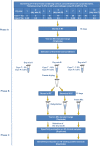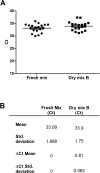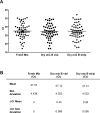Development of a dry-reagent-based qPCR to facilitate the diagnosis of Mycobacterium ulcerans infection in endemic countries
- PMID: 25830546
- PMCID: PMC4382021
- DOI: 10.1371/journal.pntd.0003606
Development of a dry-reagent-based qPCR to facilitate the diagnosis of Mycobacterium ulcerans infection in endemic countries
Abstract
Background: Buruli ulcer is a neglected tropical disease caused by Mycobacterium ulcerans. This skin disease is the third most common mycobacterial disease and its rapid diagnosis and treatment are necessary. Polymerase chain reaction (PCR) is considered to be the most sensitive method for the laboratory confirmation of Buruli ulcer. However, PCR remains expensive and involves reagents unsuitable for use in tropical countries with poor storage conditions, hindering the development of reliable quantitative PCR (qPCR) diagnosis. We aimed to overcome this problem by developing a ready-to-use dry qPCR mix for the diagnosis of M. ulcerans infection.
Methodology/principal findings: We compared the efficiency of three different dry qPCR mixes, lyophilized with various concentrations of cryoprotectants, with that of a freshly prepared mixture, for the detection of a standard range of M. ulcerans DNA concentrations. We evaluated the heat resistance of the dry mixes, comparing them with the fresh mix after heating. We also evaluated one of the dry mixes in field conditions, by analyzing 93 specimens from patients with suspected Buruli ulcers. The dry mix was (i) highly resistant to heat; (ii) of similar sensitivity and efficiency to the fresh mix and (iii) easier to use than the fresh mix.
Conclusions: Dry qPCR mixes are suitable for use in the diagnosis of M. ulcerans infection in endemic countries. The user-friendly format of this mix makes it possible for untrained staff to perform diagnostic tests with a limited risk of contamination. The possibility of using this mix in either vial or strip form provides considerable flexibility for the management of small or large amounts of sample. Thus, dry-mix qPCR could be used as a reliable tool for the diagnosis of Buruli ulcer in the field.
Conflict of interest statement
The authors have declared that no competing interests exist.
Figures





References
-
- Asiedu K, Sherpbier R, Raviglione MC (2000) Buruli Ulcer Mycobacterium ulcerans infection W.H.O. Global Buruli Ulcer initiative. Report 2000 World Health Organisation; Geneva Switzerland.
Publication types
MeSH terms
Substances
LinkOut - more resources
Full Text Sources
Other Literature Sources

